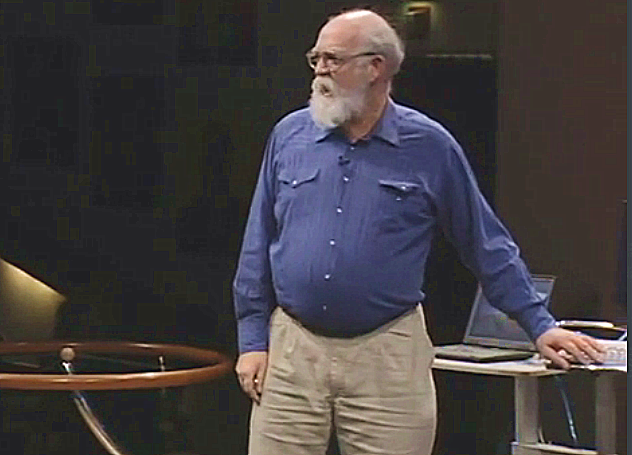But now, notice there are two ways of seeing the cube, right?
現(xiàn)在,你注意到了有兩種方法來看那個立方體,對吧?
It's a Necker cube.
這是一個內(nèi)科爾方塊。
Everybody can see the two ways of seeing the cube? OK.
大家都可以看出兩種看方塊的方法吧?好的
Can you see the four ways of seeing the cube?
那你們能看出四種方法來嗎?
Because there's another way of seeing it.
由于有不同的方法來看它。
If you're seeing it as a cube floating in front of some circles,
如果你讓方塊浮在圓圈之上,
some black circles, there's another way of seeing it.
那些黑色的圓圈,就有另一種看的方法。
As a cube, on a black background, as seen through a piece of Swiss cheese.
如果把方塊當(dāng)作放在黑色背景之上,就像是從一塊瑞士奶酪的洞里看過去。
Can you get it? How many of you can't get it? That'll help.
你們能理解嗎?多少人不能理解?這樣應(yīng)該有所幫助。
Now you can get it. These are two very different phenomena.
現(xiàn)在你們明白了。這里有兩個很不一樣的現(xiàn)象。
When you see the cube one way, behind the screen, those boundaries go away.
如果你把方塊當(dāng)作是放在屏幕之后的,邊界就沒了。

But there's still a sort of filling in, as we can tell if we look at this.
不過仍然可以把它填充出來,如果你用這種方法去看。
We don't have any trouble seeing the cube, but where does the color change?
我們可以毫無障礙的看到方塊,但是顏色是在哪里改變的呢?
Does your brain have to send little painters in there?
你的大腦在那兒放了小畫家?
The purple-painters and the green-painters fight over who's going to paint that bit behind the curtain? No.
畫紫色的畫家和畫綠色的畫家,兩者爭著要在遮擋物之后涂色嗎?不是。
Your brain just lets it go. The brain doesn't need to fill that in.
你的大腦就由它去了。大腦不需要填充它。
When I first started talking about the Bradley, Petrie, Dumais example that you just saw
當(dāng)我第一次談?wù)摰侥銊倓偪吹降?Bradley, Petrie, Dumais的例子
I'll go back to it, this one I said that there was no filling-in behind there.
讓我退回到它,這個。我說過在被擋住的地方是沒有填充顏色的。
And I supposed that that was just a flat truth, always true.
我以為這是一個公理,總是對的。
But Rob Van Lier has recently shown that it isn't.
不過 Rob Van Lier最近證明了它不是。
Now, if you think you see some pale yellow -- I'll run this a few more times.
現(xiàn)在,如果你覺得你看到了一些黃色--讓我再做幾次。
Look in the gray areas, and see if you seem to see something sort of shadowy moving in there
看這些灰色區(qū)域,你是不是好像看到有些陰影在移動
yeah, it's amazing. There's nothing there. It's no trick.
是的!那很神奇。那里沒有東西。沒耍花招。
This is Ron Rensink's work,
這是 Ron Rensink的作品,
which was in some degree inspired by that suggestion right at the end of the book.
在一定程度上,被書最后的暗示所激發(fā)。
Let me just pause this for a second if I can. This is change-blindness.
讓我暫停幾秒。這是盲變化。
What you're going to see is two pictures, one of which is slightly different from the other.
你會看到兩幅圖片,一幅與另一幅有些許區(qū)別。
You see here the red roof and the gray roof, and in between them there will be a mask,
你看這里是紅色屋頂而那里是灰色,他們之間有個遮罩,
which is just a blank screen, for about a quarter of a second.
這里只是一個空白屏幕,在大概0.25秒。
So you'll see the first picture, then a mask, then the second picture, then a mask.
所以你將看到第一幅圖,然后是遮罩。再然后是第二幅圖,然后是遮罩。
And this will just continue, and your job as the subject is to press the button when you see the change.
然后這會重復(fù),你作為實驗對象的工作就是當(dāng)你看到變化的時候按下按鈕。
So, show the original picture for 240 milliseconds. Blank.
所以是,原始圖片出現(xiàn)240毫秒。空白。
Show the next picture for 240 milliseconds. Blank.
下一幅圖片出現(xiàn)240毫秒。空白。
And keep going, until the subject presses the button, saying, "I see the change."
這會一直持續(xù),直到實驗對象按下按鈕,表示“我看到變化了。”
So now we're going to be subjects in the experiment.
好,現(xiàn)在我們就是實驗對象。
We're going to start easy. Some examples.
我們從簡單的開始。一個例子。



